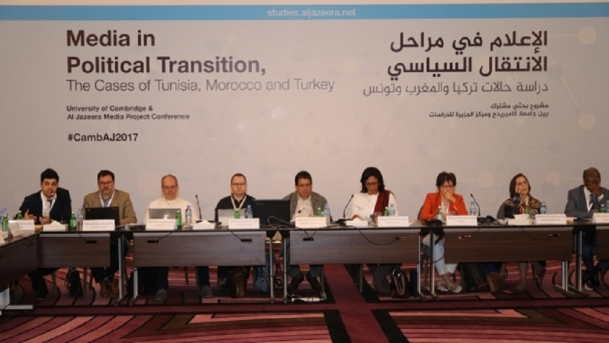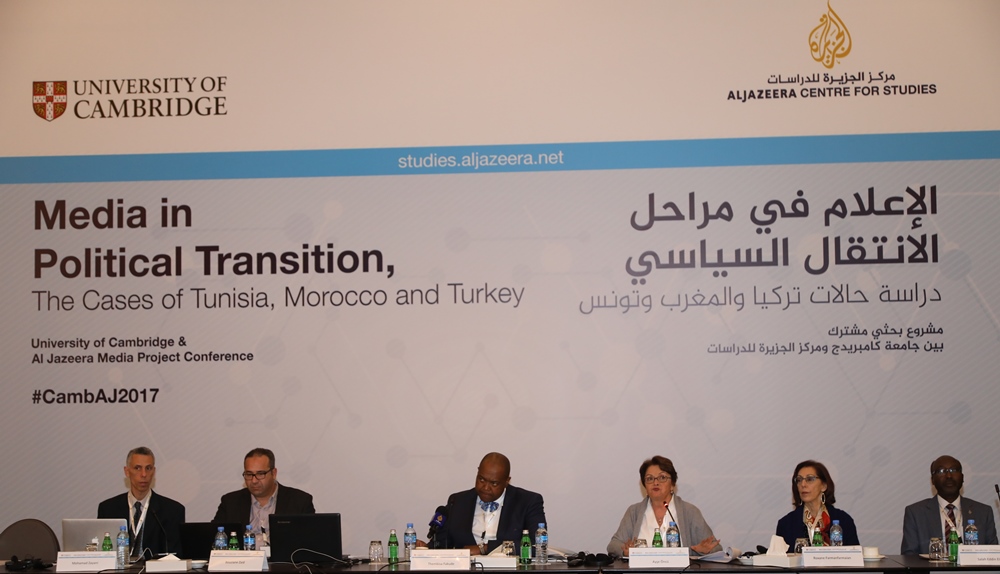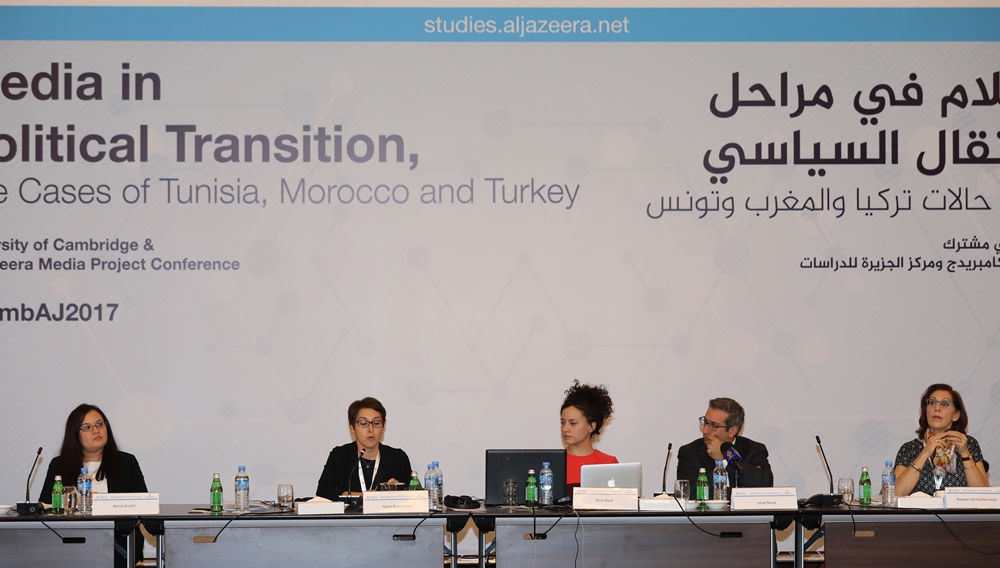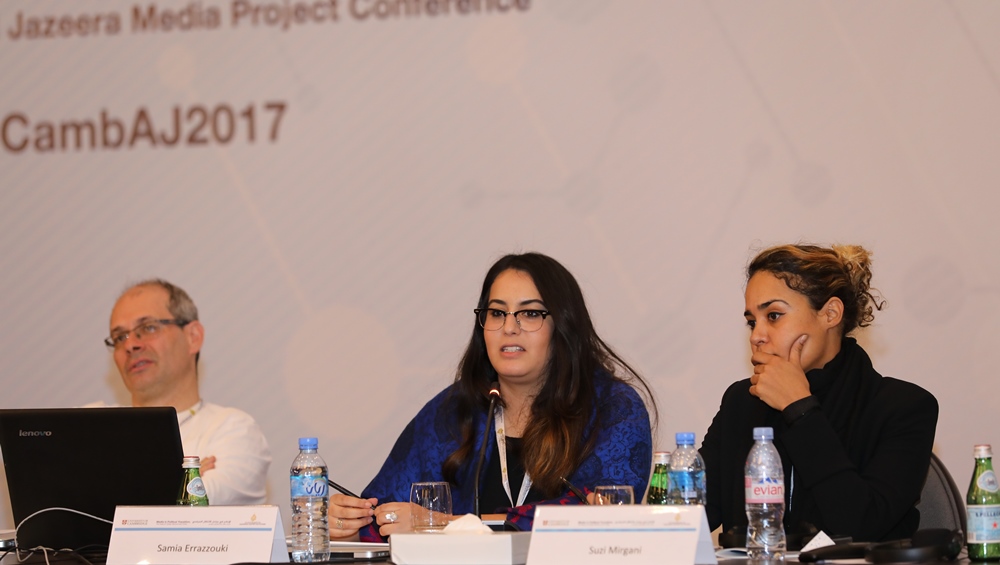
Introduction
As part of the research project on media in political transition in the Middle East and North Africa, a joint endeavour between Al Jazeera Centre for Studies (AJCS) and the Centre for the Study of the International Relations of the Middle East and North Africa (CIRMENA) at the University of Cambridge, an academic conference was held on 7–8 January 2017, where academics and researchers discussed the preliminary findings of research conducted in the second phase of the project, which began at the end of 2014 and focused on Morocco and Turkey. The original research papers, prepared by two research teams from the two countries, looked at how the media, in its relationship to state power, engages with political tensions and the evolution of popular narratives surrounding the events of 2011–2013.
The first phase of the project, which began in 2013, focused on the media in Tunisia. Titled “Media in Political Transition: The Case of Tunisia”, it examined the transformations seen in the Tunisian media after the revolution. That stage of the project culminated in the publication of the research papers in a special issue of the Journal of North African Studies, published by the University of Cambridge, followed by an Arabic-language book published by AJCS.
Focusing on the cases of Turkey, Morocco and Tunisia, the project seeks to conduct a comparative study of media systems in Mediterranean countries across three axes: structure, function and agency. Within these axes, it addresses topics related to internet freedom and surveillance, political discourse, the use of social media, gender issues on television and in public life, media professionalism and partisanship, the emergence of Islamist media, and competition among political elites to capture the media. Looking at Turkey and Morocco in addition to Tunisia allows a fuller picture of how government and media in the region have responded to political tensions and changes in the popular discourse on the events of 2011–2013 to emerge.
The structure of the media in political transition
This was the theme of the first round of conference panels. Dr. Salah Eddin Elzein, the director of AJCS, gave the opening talk of the conference, highlighting important shifts in the media landscape and their relationship with profound political and social developments as well as the revolution in communications and information technology. These seismic changes, in fact, spurred AJCS to establish a new programme for media studies, dedicated to the study of transformations in media and communication in the Middle East and North Africa in particular. The program aims to contribute to robust, academic knowledge of contemporary media and its relationship with its political and social context, analyse and interpret variations, drivers of change and trends, and continually develop this body of knowledge through applied studies.
Dr. Elzein spoke of the importance of the joint research project between AJCS and the CIRMENA. He said AJCS was eager to expand the discussion of the project’s outcomes through this conference, which presents the preliminary findings of research on the changing media landscape in Turkey, Morocco and Tunisia, and was looking forward to a discussion of the researchers’ theses by a select group of media professors, academics, other researchers and practitioners in order to enrich the conclusions of the project. This conference was preceded by four workshops, two in Cambridge and two in Doha, all of which examined the findings of studies conducted by the researchers participating in the project on media in political transition.
In introducing the project, Dr. Roxane Farmanfarmaian, the director of the joint project between Al Jazeera Centre for Studies (AJCS) and CIRMENA, said that the strength of this research lies in the comparative study of the media systems of three distinct systems of governance (a democratic transition in Turkey, a monarchy in Morocco and a post-revolutionary experiment with political pluralism in Tunisia). In each of the three contexts, the research examines media as a tool of state power and an instrument of social expression, allowing a comparative analysis of the intersection of politics and media in these states, an area that has yet to be explored in any depth. Since the media is both an instrument of power and a reflection of it—whether used by the government, military, intelligence services, private sector or civil society groups—an analysis of the media will therefore shed new light and offer a different perspective on policy structures and incentives as well as modernisation processes in these countries.
Dr. Asli Tunç, a professor of media communications systems at Istanbul Bilgi University, presented a paper titled, “All is Flux: A Macro Analysis of the Turkish Media Scene from a Hybrid Media System Perspective”. The paper examined the gradual evolution of the Turkish media, noting that media market has been shifting since 2002, when the Justice and Development Party (AKP) first came to power, as political parties became state institutions, cultural entities became ethnic identities, and military organisations became civil society organisations. This transformation served to strengthen some players and sideline others. Dr. Tunç also addressed the impact of the fascist coup attempt of 15 July 2016 on the Turkish political and media landscape, focusing on the changing role of newspapers and television channels as well as the professionalism of journalism. For the purposes of her research, she conducted in-depth interviews with well-known opinion leaders, local politicians, veteran media workers, journalism associations, and representatives of the media. She concluded from her analysis that the functions of the media sector are determined at the intersection of “patronage networks, authoritarian tendencies and the rules of the capitalist market”.
A joint research paper, titled “The Media and Power Landscape in Morocco,” was presented by Dr. Driss Ksikes, a professor of media, culture and creative writing at the Institut des Hautes Etudes de Management in Morocco; Dr. Abdelfettah Benchenna, a lecturer in media studies and communication at Paris XIII University; and Dominique Marchetti, the research director at the European Centre for Sociology and Political Science. The researchers looked at the changing media landscape in the country and its relationship to the state in Morocco’s modern history. They found that in the 1990s, there were promises of media sector reform and that era saw newspapers that crossed the red lines, but this opening soon narrowed. The researchers concluded that the multiplicity of newspapers in Morocco is no more than an illusion of plentitude, as newspaper readership has declined in favour of websites, which now attract 2.5 million visitors daily.
The paper noted that academic research tends to compare the media in Morocco either to the post-Soviet media, with its mixed regulation and private investment that has no influence on the power structure, or the media of post-dictatorship southern Europe, with its combination of poor levels of professionalism and strong state interference, not to establish rules, but to entrench financial patronage networks. But there has been little research on Morocco. The main fieldwork focuses on the private press, news magazines, and the top-tier workers (entities limited to virtual space), which appeared in the mid-1990s, focusing on: 1) the political economy of press companies; 2) the oligopoly and the organisations and forms of economic control; 3) and the social geography of press owners and managers.
Dr. Ali Sonay, a researcher with the joint project between Cambridge University and AJCS, presented a paper titled, “Local Media in Turkey: The Development of the Radio Landscape in Konya.,” which looked at changes seen in Turkey in the political, economic, and social arenas since the rise of the AKP in 2002. Dr. Sonay linked economic and political liberalisation with several salient issues of recent years, most significantly the presence of religion in the public sphere and the concomitant emergence of a new conservative middle class and its social, political and economic influence in shaping the boundaries of what can be thought and said about Turkish identity. Within this landscape, the media has become one arena to discuss this ongoing process.
In this context, and with the aim of understanding current media developments, Dr. Sonay’s paper focused on radio as a marginal institution, asking how radio in central Anatolia—the site of the emergence of the conservative bourgeoisie in recent decades—reflects this shift. Interviews and observations were limited to Konya, a politically and economically important city and an AKP stronghold. Fieldwork revealed a growing aspiration to commercialise the media and a strong focus on the local level, which influences the dominant music radio stations while also reshaping the nature of Islamist radio stations.
Media surveillance
Dr. Erkan Saka, a professor of media and communications at Istanbul Bilgi University, presented a paper titled “Social Media in Turkey as a space for political battles: An introduction to AKP Trolls and other politically motivated trolls in Turkey”. Dr. Saka examined the ruling AKP’s engagement with the Gezi Park protests in 2013. In the wake of the protests, the AKP mobilised an online army to confront the growing dominance of Gezi Park demonstrators on social media. Starting in December 2013, during the investigation into corruption, the old alliance between the Fethullah Gülen movement and the Justice and Development Party (AKP) collapsed into open acrimony. Since then, the Gulenist movement has been using social media effectively to stir opposition to the ruling AKP. The paper made particular use of studies on digital activism, participatory cultures, and internet use, and looked at the political economy of the Turkish media, with the goal of framing current political struggles on social media.
Structure and governance
In the final panel of the first day, Dr. Ayse Öncü, professor emeritus of sociology at Istanbul Bilgi University, presented a paper titled “Government-Media Relations in Turkey: The Makings of an Authoritarian Order”. Dr. Öncü explained that the transformation of the Turkish media landscape in the 1990s resembled what Daniel C. Hallin and Paolo Mancini called “savage deregulation” to describe the liberalisation of media markets in countries like Greece, Italy and Spain. The media system that arose out of Turkey’s historical experience in particular is characterised by the overwhelming dominance of commercial/popular television on the public sphere, rapid conglomeration through common ownership and investment in various sectors of the economy, and flexible reciprocal relationships (patronage-based, corporate and instrumental) between the media elite and government circles.
Öncü’s paper reviewed the media landscape in the wake of the failed coup attempt of 15 July 2016, after which 130 media outlets were shut down, including broadcast media, print and some 30 publishing houses, and their assets transferred to the state treasury. In this context, the paper looked at the vital importance of media management and public relations strategies in inflating the person of Erdogan and transforming him into the embodiment of Turkish unity in the future.
In a paper titled “The Structure of Media in Political Transition in Morocco,” Dr. Zaid Bouziane, professor of media and communications at al-Akhawayn University in Morocco, explored the complex process of media reforms in democracies in transition. In Morocco, the wave of political and democratic liberalisation in the second half of the 1990s brought about major media reforms, particularly in the broadcasting sector. The High Commission for Audiovisual Communication, established in 2002, was tasked with establishing a legal framework for the liberalisation of the audiovisual sector and overseeing the public broadcasting services. In 2016, a new press law was adopted with regulations that apply to the internet, replacing the old press law of 2002.
Dr. Bouziane said that the internet in Morocco is marked by a digital gap and the emergence of a surveillance community, which has turned information technology and communications from forces for change into instruments of state repression. The rise of networked communities briefly changed the dynamics between the media, culture and politics during the Arab Spring, but the state has managed to again exclude these spaces from the competition to establish other ways of being and seeing. Bouziane also took up the legal context and institutional structures of media reform in Morocco, noting that their oppositional tendencies indicate the existence of a competitive authoritarian system instead of a democracy in transition. Morocco has yet to fulfill the promise of media democratisation and break with the past use of media as an instrument of political propaganda and control.
Agency and representation
On the second day of the conference, participants turned to the theme of the legal and regulatory system that structures the relationship between the government and media. In this context, Dr. Ayse Seda Yuksel, a researcher at the Istanbul Studies Center at Kadir Has University, presented a paper titled “Representation of Terror and Ethnic Conflict in the Turkish Press: An Analysis of the Peace Process in Turkey”. Dr. Yuksel noted that the Turkish media has long been a pillar for Turkish nationalism, tending to define the Turkish people through the lens of anticipated domestic and foreign threats. In the 1990s, during that period of nationalist discourse, the “east” was implicitly identified with Kurdish ethnicity, while the Kurdistan Workers’ Party (PKK) was explicitly branded as ‘terrorist’. In her paper, Dr. Yuksel focused on the period from April to November 2015, when tension between the Turkish state and the PKK had subsided in tandem with the peace process, which was officially announced by the Turkish government in 2013. The beginning of skirmishes between the two sides in 2015 coincided with the intensification of the Syrian war, the reshaping of the other side of Turkey’s southeastern border, and the profound domestic political polarisation between the AKP and the opposition on the eve of national elections in June 2015.
Focusing on four newspapers (Yeni ?afak, Milliyet, Zaman and Cumhuriyet) affiliated with various ideological stances and diverse economic ties to the central government, Yuksel revealed differences in the way the reduced tensions and the Kurdish issue were framed within the major print media. The return of a discourse of “terrorism” and ethnic conflict in 2015 not only permits a discussion of any new representation or conception of the long-running Kurdish issue, but also allows a treatment of how media discourse about peace is constructed.
In a paper titled “Corporatism and fears: Islamist press in Turkey after June 2013”, Dr. Michelangelo Guida, professor and chair of the department of political science and international relations at Istanbul 29 May University, identified two events that exercised enormous pressure and spurred the Islamist press to adapt to institutional relationships: the Gezi Park protests and the corruption scandals of December 2013. His paper examined some of the interpretations of these two events offered by major columnists in three of the most significant Islamist papers after June 2013. In particular, it analysed the work of star columnists such as Fehmi Koru (Yeni ?afak), Ibrahim Karagul and Ali Bulac (Zaman) after the Gezi Park protests and the revelation of the corruption scandals, looking at their understanding of the events and the formation of Islamist opinion. The paper also shed light on the role of fear and lack of self-confidence in the life of various segments of the people. In addition, an overview of newspaper ownership, as well as interviews with writers, can contribute to an understanding of the pressures of institutional relationships between politics, civil society, media and the economy.

In another paper presented by Dr. Ali Sonay, “Liberalizing Media in Authoritarian Contexts: Radio Listening in Contemporary Morocco”, he noted that despite the important changes seen in Morocco in the context of the Arab Spring, the domestic conversation about democratic transition continues to move toward more political participation and freedoms. Dr. Sonay said that the media is simultaneously one of the chief topics of this discussion and a platform for it. Since the liberalisation of the radio sector in 2005, which was previously under state control, 19 private stations have been established, joining the existing public stations.
To understand the communication behaviour and preferences of radio audiences in Morocco, a field study was conducted focusing on taxi drivers, a major segment of radio listeners. An online survey of the listening preferences of students also helped to make generational comparisons between the two groups. The research indicated that the radio is extremely popular, as it has made music, religion and talk shows—previously socially taboo—popular. In turn, this has sparked a debate about the influence of radio on freedom of expression and moral standards.
In her paper, titled “Mediapreneurship in Morocco (Tunisia and Turkey): Web Resistance 2.0”, Dr. Roxane Farmanfarmaian focused on the role of social media networks in political transition in Tunisia and Morocco. Protest movements used these media to highlight their activities and disseminate their messages and discourses, which heightened a sense for the potential to use available opportunities and influence the future as well as create some momentum internationally. Dr. Farmanfarmaian said that protests broke the barrier of fear. Collective media action on social media networks also had an impact on activities in the field and helped create the political opportunities and empowerment that followed from it. She first elaborated on the opportunities created by social networks in the case of Tunisia. The self-immolation of Mohamed Bouazizi ignited an opportunity for political action; the event was the point at which the anger that existed in that period coalesced and the response to that political opportunity was revolutionary. Farmanfarmaian also said that another set of political opportunities is replicable whenever there is a social movement in transitional cases.
In Morocco, the use of social media was effective in protests because, according to Farmanfarmaian’s paper, the old ways of preparing news reports were no longer credible and journalists were, in the eyes of protestors, part of the official establishment. She added that social media was effective around the Middle East, as people obtained and exchanged news and information more from these platforms than from television.
Women in talk shows
This was the theme of the final panel of the conference. Dr. Ye?im Burul Seven, a professor of media, film and television at Istanbul Bilgi University, and Dr. Hande Eslen-Ziya, a research fellow at KwaZulu-Natal University in Durban, presented a joint research paper titled, “Understanding the “New Turkey” through the Eyes of Women: Gender Politics in Turkish Daytime Talk Shows”. The paper discussed important changes made to the AKP’s platform and strategy in the wake of its second electoral victory in 2007. These changes transformed Turkey into a new functional space and arena for discourse: the new Turkey. This motto not only set the parameters for Turkish democracy, but also raised issues of gender equality and women’s status.
During this period, the Turkish government gave free rein to its patriarchal discourse. Since the media is a significant tool of hegemony, with political actors competing through it to establish their influence, an analysis of what is said on daytime television reflects the process of manufacturing ideal gender roles in Turkish society. The researchers offered an analysis of one of the most popular daytime talk shows in Turkey, hosted by Seda Sayan. Sayan’s show typically hosts guests in a live studio, with the audience expressing itself on issues related to gender politics. Using discourse analysis and looking at common episode issues, the researchers studied the roles assigned to both men and women and the reactions of audience members. The analysis also included responses to the show’s content from various women’s organisations and female activists on social media and media coverage in general.

Dr. Kenza Oumlil, a professor of communication and gender at al-Akhawayn University in Morocco, presented a paper titled “The Representation of Women in Moroccan Television Talk Shows”. Dr. Oumlil noted that women’s representation in Moroccan media has garnered little interest in academic research, and that there is no published research in English on the topic. Her paper thus aimed to fill this gap in academic study by looking at the formation of women’s identity on talk shows on Moroccan television. She also used discourse analysis to examine select episodes from 2012 to 2015, taken from outstanding television programs, such as “Issues and Opinions”, “Live with You”, “Straight Talk” and “Sixty Minutes of Understanding.” The episodes were chosen on the basis of the show’s fame, the episode’s popularity and its relation to the topic of the study. The paper found that the episodes functioned in a pedagogical way, raising awareness and educating viewers on women’s rights, laws or civil society initiatives. In particular, the episodes highlight social, cultural and legal injustice and obstacles facing women in Moroccan society. They also spotlight the slow progress made on women’s rights and offer suggestions for future directions. Although the female guests on the shows offer a strongly feminine image, the episodes ultimately convey the need for self-expression and representation.
